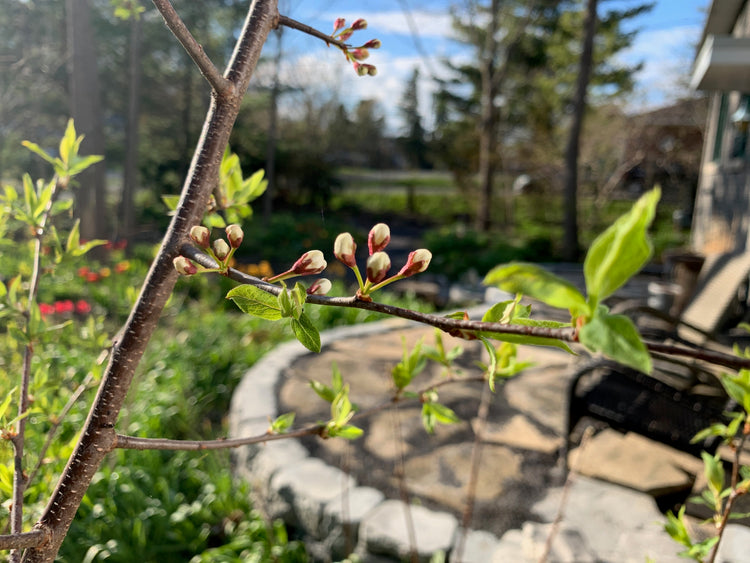Pocket Forests are densely-planted, multilayered forest communities. They reconnect fragmented habitats, restore biodiversity, build climate resilience, and bring the magic of Nature to your doorstep. Our method is inspired by Japanese botanist Dr. Akira Miyawaki. While the trees we plant are little, they'll quickly outgrow those planted using conventional methods.
Five reasons to plant a Pocket Forest
- Biodiversity: offer refuge and food for the web of life (insects, pollinators, birds, soil microbes and more)
- Climate resilience: cool your home, create a windbreak, sink and absorb rainwater, filter air pollution
- Sanctuary: create privacy, hide unsightly views and reduce noise with a living screen
- Wellbeing: reduce stress, diversify your gut microbiome, and increase feelings of connection and engagement with Nature
- Enchantment: bring joy, wonder, and hope to your neighbourhood.
Pocket Forest Kits
We have a Pocket Forest Kit to fit even the most challenging landscape condition and for a variety of design goals.
Each kit includes between 6 and 45 native trees and shrubs and a pinch of magic dust (mycorrhizal fungi), plus resources and support to help you create and care for your Pocket Forest. Final species selection for each kit is dependent on species availability and your goals.
Food Forest: harvest nuts, fruits, and berries

Have you ever experienced the fabulous scent and flavour of a PawPaw, Canada's only native tropical fruit? Grow delicious nuts, fruit, and berries for yourself and to share with your other-than human friends.
Canopy layer: Hickory (Carya ovata, Carya laciniosa), Black Walnut (Juglans nigra), American Chestnut (Castanea dentata), Ultra Northern Pecan (Carya illinoinesis), White Oak (Quercus alba), Bur Oak (Quercus macrocarpa), Butternut (Juglans cinera)
Understory layer: Pawpaw (Asimina triloba) , Red Mulberry (Morus rubra), Serviceberry (Amelanchier canadensis) , Redbud (Cercis canadensis), Persimmon (Diospyros virginiana), Canada Plum (Prunus nigra)
Shrub layer: Elderberry (Sambucus nigra ssp. canadensis), Aronia (Aronia), Leadplant (Amorpha canescens), New Jersey Tea (Ceanothus americanus), Sweet Gale (Myrica gale), Carolina Rose (Rosa carolina), Prickly Gooseberry (Ribes cynosbati), American Black Currant (Ribes Americanum), American Hazel (Corylus americana)
Wet Feet: turn your yard into a sponge

Wet Feet is great for wet spots (like this low spot into which a sump pump drains) or rain gardens. Trees like Yellow Birch, Buttonbush and Dogwood are happy to act as a sponge for your yard’s wet spot. Trees like Red Maple, Speckled Alder, Birch, and Pussy Willow are also critical pollen and nectar sources for our earliest pollinators.
Canopy layer: Red Maple (Acer rubrum), Silver Maple (Acer saccharinum), Swamp White Oak (Quercus bicolor), Pin Oak (Quercus palustris), Balsam Fir (Abies balsamea), Blue Ash (Fraxinus quadrangulata), Tamarack (Larix laricina), Eastern Cottonwood (Populus deltoides)
Understory layer: Pussy Willow (Salix discolor), Elderberry (Sambucus canadensis), Beaked Hazelnut (Corylus cornuta), Blue Beech (Carpinus caroliniana), Speckled Alder (Alnus incana), Hop Hornbeam (Ostrya virginiana)
Shrub layer: Aronia (Aronia melanocarpa), Swamp rose (Rosa palustris), Buttonbush (Cephalanthus occidentalis), Sweet Gale (Myrica gale), Spicebush (Lindera benzoin), Meadowsweet (Spirea alba), Wiinterberry (Ilex verticillata)
For the Birds

Bring feathered friends flocking to your yard! In addition to nesting habitat, For the BIrds has a selection of trees that support different species of birds throughout the season with berries, fruits, seeds, nuts, sap, nectar, and insects.
Canopy layer: Hackberry (Celtis occidentalis), Oaks (Quercus), Maples (Acer spp.), Wild Black Cherry (Prunus serotina), White Pine (Pinus strobus), Red Cedar (Juniperus virgininiana), Birch (Betula spp.)
Understory layer: Serviceberry (Amelanchier spp.), Mountain Ash (Sorbus americana), Alternate-Leaf Dogwood (Cornus alternifolia), American Plum (Prunus americana), Sweet Crabapple (Malus coronaria), Flowering Dogwood (Cornus florida), Sassafras (Sassafras albidum), Red Mulberry (Morus rubra)
Shrub layer: Aronia (Aronia melanocarpa), Spicebush (Lindera benzoin), Witherrod Viburnum (Viburnum nudum var. cassinoides), Highbush Cranberry (Viburnum opulus var. americanum), Nannyberry (Viburnum lentago), Red Elderberry (Sambucus racemosa), Red Osier Dogwood (Cornus sericea), Mapleleaf Viburnum (Viburnum acerifolium), Wild Roses (Rosa spp.), Flowering Raspberry (Rubus odoratus), Fragrant Sumac (Rhus aromatica), Wiinterberry (Ilex verticillata), Northern bayberry (Myrica pensylvanica)
Keystone Forest
Just 14% of trees support 90% species of caterpillars. Caterpillars are the basis of the food web, essential for birds when raising their young and for specialist native bees! We've designed this Pocket Forest to include as many keystone native trees and shrubs as possible.
Canopy layer: Oaks (Quercus spp.), Sugar Maple (Acer saccharum), Hackberry (Celtis occidentalis), White Pine (Pinus strobus), Red Maple (Acer rubrum), Black Cherry (Prunus serotina), Hickories (Carya spp.), Birches (Betula spp.), Basswood (Tilia americana)
Understory layer: Highbush Cranberry (Viburnum trilobum), Mountain Ash (Sorbus americana), American Hazelnut (Corylus americana), Serviceberry (Amelanchier spp.), Witch Hazel (Hamamelis virginiana), Speckled Alder (Alnus incana), Hop Hornbeam (Ostrya virginiana), Chokecherry (Prunus virginiana), American Plum (Prunus americana), Canadian Plum (Prunus canadensis), Sweet Crabapple (Malus coronaria), American Hazel (Corylus americana)
Shrub layer: Snowberry (Symphiocarpus albus), Red Osier Dogwood (Cornus sericea), Golden Currant (Ribes aureum), Ninebark (Physocarpus opulifolus), Bayberry (Myrica pensylvanica), Wild Roses (Rosa spp.)
Butterfly Banquet

Love Swallowtail Butterflies? How about Luna Moths, Silk Moths or Imperial Moths? Many Butterfly and Moth species rely on specific host trees for their young. Butterfly Banquet to the rescue!
Canopy layer: Tulip Tree (Lirodendron tulipifera), Basswood (Tilia americana), Black Walnut (Juglans nigra), Oaks (Quercus spp.), Wild Black Cherry (Prunus serotina), Hackberry (Celtis occidentalis), Hickories (Carya spp.), Maple (Acer spp.)
Understory layer: Pawpaw (Asiimina triloba), Sassafras (Sassafras albidum), Hop Hornbeam (Ostrya virginiana)
Shrub layer: Spicebush (Lindera benzoin), Hoptree (Ptelea trifoliata), New Jersey Tea (Ceanothus americanus), Snowberry (Symphoricarpos albus)
Climate Hero

Carbon sequestration to the max! Some grow fast, storing carbon in their youth. Others grow slow, but store carbon for generations. While we've listed only two shrub species, all shrubs are amazing climate heros as they grow much faster than trees.
Canopy layer: Silver Maple (Acer saccharinum), Red Maple (Acer rubrum), Birches (Betula spp.), Northern Catalpa (Catalpa speciosa), Hackberry (Celtis occidentalis), Honey Locust (Gleditisia triacanthos), Kentucky Coffeetree (Gymnocladus dioicus), Black Walnut (Juglans nigra), Tulip Tree (Liriodendron tulipifera), Black Gum (Nyssa svlvatica), American Sycamore (Platanus occidentalis), Eastern Cottonwood (Populus deltoides), Wild Black Cherry (Prunus serotina), Oaks (Quercus spp.), Hickories (Carya spp.), Basswood (Tilia americana), Elms (Ulmus spp.), Cucumber Magnolia (Magnolia acuminata)
Understory layer: Yellowwood (Cladrastis kentukea), Persimmon (Diospyros virginiana), Red Mulberry (Morus rubra)
Shrubs: High Bush Blueberry (Vaccinium corymbosum), Hoptree (Ptelea trifoliata), Bayberry (Myrica pensylvanica)
Rocky Roots

Have shallow soil over rock (like the shallow rocky ditch next to a concrete wall above)? You can still plant a Pocket Forest! We've sought out inspiration for this Pocket Forest from Alvar forest communities. Alvars have a thin covering of soil (or no soil at all), over a base of limestone or dolostone.
Canopy layer: Chinquapin Oak (Quercus muehlenbergii), Red Oak (Quercus rubra), Bur Oak (Quercus macrocarpa), Swamp White Oak (Quercus Shagbark Hickory (Carya ovata), White Pine (Pinus strobus), White Birch (Betula papyrifera), Trembling Aspen (Populus tremuloides), Balsam Fir (Abies balsamea), Kentucky Coffee Tree (Gymnocladus dioicus), Easter Red Cedar (Juniperus virginiana), Red Maple (Acer rubrum), Northern White Cedar (Thuja occidentalis), Balsam Poplar (Populus balsamifera)
Understory layer: Pin Cherry (Prunus pensylvanica), American Plum (Prunus americana), Ironwood (Ostrya virginiana), Basswood (Tilia americana), Sassafras (Sassafras albidum), Striped Maple (Acer pensylvanicum)
Shrub layer: Glaucous Honeysuckle (Lonicera dioica), Buffalobery (Shepherdia canadensis), Snowberry (Symphoricarpos albus), New Jersey Tea (Ceanothus americanus), Ninebark (Physocarpus opulofolius), Hoptree (Ptelea trifoliata), Dwarf Serviceberry (Amelanchier spicata), American Fly Honeysuckle (Lonicera canadensis), Beaked Hazelnut (Corylus cornuta), Shrubby cinquefoil (Dasiphora fruticosa), Choke Cherry (Prunus virginiana), Fragrant Sumac (Rhus aromatica), Red-osier Dogwood (Cornus sericea), Kalm’s St. John’s-wort (Hypericum kalmianum), Alder-leaved Buckthorn (Rhamnus alnifolia), Smooth Rose (Rosa blanda), Gray dogwood (Cornus racemosa), Silky Dogwood (Cornus amomum), Dwarf Chinquapin Oak (Quercus prinoides)
Small but Mighty
You don't need a large space to make a big impact! Do you have have a pocket sized yard? A location close to a powerline or underground utilities? Or existing large trees and would like to increase biodiversity and climate resilience by planting a layered understory.
You can plant a Small but Mighty version of any of the above kits, choosing from the Understory and Shrub layers.
Are you interested in a Pocket Forest?
Because Pocket Forests are gifts to the Earth, we offer them in the spirit of the gift. Read more about our gift model in Pocket Forests are gifts to the Earth.
Use this order button to book a consultation or send us an email.

